Table of Contents
What is a solution Architect?
A solution architect is a technical leader responsible for defining the architecture of a software system, ensuring that it meets business and technical requirements, and aligning with the organization’s technology strategy. They work with stakeholders to understand requirements, analyze and design solutions, and oversee the implementation and deployment of the system.
Architectural Responsibilities of Architect
Enterprise Architect: An enterprise architect is responsible for defining and maintaining the overall architecture of an organization. They work at a high level and focus on aligning technology with the organization’s business strategy and goals.
Solution Architect: A solution architect is responsible for designing and implementing technology solutions that meet the specific needs of a business. They focus on delivering end-to-end solutions that integrate multiple systems and meet business requirements.
Software Architect: A software architect is responsible for designing and implementing the architecture of software systems. They focus on the technical design of software systems and ensure that the software meets the functional and non-functional requirements of the organization.
These types of architects often work together and may overlap in their responsibilities. For example, a solution architect may also be involved in defining the overall architecture of an organization, and an enterprise architect may also be involved in the design of specific technology solutions. The specific roles and responsibilities of each type of architect may vary depending on the organization and the specific project.
What Is The Role Of A Solutions Architect?
A solutions architect is responsible for the design, development and implementation of a technology solution that meets the business requirements. The key roles of a solutions architect include:
- Understanding business requirements and goals
- Defining technical architecture and solution design
- Overseeing development and implementation
- Ensuring solution alignment with company technology strategy
- Providing technical guidance and leadership to development teams
- Collaborating with stakeholders to ensure successful solution delivery
- Evaluating and recommending technology solutions and tools.
- Overall, a solutions architect plays a critical role in ensuring that technology solutions meet the needs of the business, are scalable and sustainable, and align with the organization’s overall technology strategy.
Also Read – What is Staff Augmentation
What Are The Responsibilities Of A Solution Architect In IT Company?
A solution architect in an IT company has the following responsibilities:
- Understanding business requirements: This includes working with business stakeholders to understand their goals, requirements and pain points. The solution architect translates these requirements into a technical solution.
- Defining the technical architecture: This involves creating a high-level design of the technical solution, which includes the technology components and their interactions. The solution architect considers factors such as scalability, security, performance, and maintainability when defining the technical architecture.
- Finalizing Tech Stack – a solution architect is often involved in finalizing the technology stack for a project. The technology stack refers to the set of technologies and tools that will be used to build and implement a solution. The solution architect works with development teams and business stakeholders to understand the requirements and constraints of the project, and then evaluates different technology options to determine the best fit. This involves considering factors such as cost, scalability, security, and ease of use.
- Overseeing development and implementation: The solution architect works closely with development teams to ensure the implementation of the solution aligns with the technical architecture. They provide guidance and mentorship to developers as needed.
- Ensuring solution alignment with company technology strategy: The solution architect ensures that the solution being delivered aligns with the company’s overall technology strategy and roadmap. They help to drive technology standardization and consistency across the organization.
- Collaborating with stakeholders: The solution architect communicates and collaborates with a wide range of stakeholders, including business leaders, developers, operations teams and vendors, to ensure the solution is delivered on time, within budget and meets quality standards.
- Evaluating and recommending technology solutions: The solution architect stays up-to-date with current and emerging technologies and evaluates their suitability for the organization. They make recommendations on technology solutions that can be leveraged to improve the solution being delivered.
- Maintaining technical documentation: The solution architect maintains technical documentation such as architecture diagrams, design documents and technical specifications to ensure that the solution is well-documented and can be maintained and supported over time.
- Identify and Managing Risk: The solution architect assesses and manages the risk associated with the solution being delivered. They ensure that the solution is secure, scalable and sustainable.
Overall, a solution architect plays a critical role in ensuring that technology solutions meet the business requirements, are delivered on time and within budget, and align with the organization’s technology strategy.
When we need a Solution Architect?
A solution architect is typically needed in the following scenarios:
- Large and complex projects: When a project is large and complex, a solution architect is needed to ensure that the technical solution meets the business requirements and is delivered on time and within budget.
- Technology transformation: When an organization is undergoing a technology transformation, such as a move to the cloud or the implementation of a new technology platform, a solution architect is needed to ensure that the technology solutions align with the organization’s technology strategy.
- Integration of multiple systems: When multiple systems need to be integrated, a solution architect is needed to design a technical solution that meets the business requirements and integrates the systems effectively.
- Compliance requirements: When an organization needs to meet regulatory or compliance requirements, a solution architect is needed to ensure that the technology solution meets these requirements.
- Change management: When an organization needs to manage change effectively, such as the introduction of new technology solutions or processes, a solution architect is needed to provide guidance and direction to development teams.
Overall, a solution architect is typically needed when a project is complex or involves significant change, and when the organization needs to ensure that technology solutions align with the business goals and are delivered successfully.
What is the Salary of a Solution Architect?
The salary of a junior solution architect can vary greatly depending on factors such as location, industry, company size, and experience. On average, a junior solution architect can expect to earn between $80,000 and $120,000 per year in the United States. However, salaries in other countries and regions can be significantly different.
The salary of a senior and experienced solution architect can vary greatly depending on factors such as location, industry, company size, and experience. On average, a senior solution architect can expect to earn between $120,000 and $200,000 per year in the United States. However, salaries in other countries and regions can be significantly different.
Is Solution Architect A Good Career Option?
Yes, a solution architect career can be a good option for those with a strong technical background, excellent problem-solving skills, and an ability to understand and translate business requirements into technical solutions. It can offer challenging work, opportunities for growth, and high earning potential.



